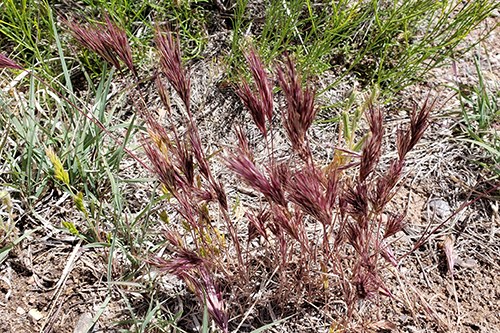
NPS/Hallie Larsen Nonnative species (also referred to as invasives, exotics, introduced, or nonindigenous species) have been introduced intentionally or unintentionally into new ecosystems. An invasive species is a nonnative whose introduction causes or is likely to cause economic or environmental harm or harm to human health. Invasive species take over habitat, squeezing out the native flora and fauna. This reduces biodiversity, interferes with soil productivity, damages or replaces native populations, and changes land and water quality. Each year invasive plants cause billions of dollars in damage to public and private lands and the ecosystems upon which we all depend. In the National Park Service, 196 national park areas have serious problems posed by invasive plant species. The costs of managing weeds were estimated at $80 million from 1996-2000. 
NPS/Hallie Larsen 
NPS/Hallie Larsen Russian olives and tamarisk, or saltcedar, were introduced to the Southwest with the good intentions of providing ornamental plants and natural erosional controls. Unfortunately, these invasive species have taken over a lot of native habitat. They crowd out cottonwoods and willows at water sources, which in turn affects migrating and breeding bird species. The result has been a significant decrease in biodiversity and ecosystem health along much of the Colorado Plateau's waterways, including waterways within Petrified Forest National Park.
Common invasive plants at Petrified Forest National Park Five-stamen Tamarisk (Tamarix chinensis) Tumbleweed (Salsola tragus) Russian Knapweed (Leuzea repens) Common Purslane (Portulaca oleracea) White Sweetclover (Melilotus albus) Yellow Sweetclover (Melilotus officinalis) Heart-podded Hoary Cress (Lepidium aka Cardaria draba) Puncture Vine (Tribulus terrestris) Camel Thorn (Alhagi maurorum) Great Mullein (Verbascum Thapsus) Russian Olive (Elaeagnus angustifolia) Tree-of-Heaven (Ailanthus altissima) Siberian Elm (Ulmus pumila) Prickly Sowthistle (Sonchus asper) Common Stork's-Bill (Erodium cicutarium) Red Brome (Bromus rubens) Musk Thistle (Carduus nutans) Wand Mullein (Verbascum virgatum) White Horehound (Marrubium vulgare) Prickly Lettuce (Lactuca serriola) Field Bindweed (Convolvulus arvensis) Tumble Mustard (Sisymbrium altissimum) Yellow Salsify (Tragopogon dubius) Cheatgrass (Bromus tectorum) Flixweed (Descurainia sophia) |
Last updated: September 13, 2020
